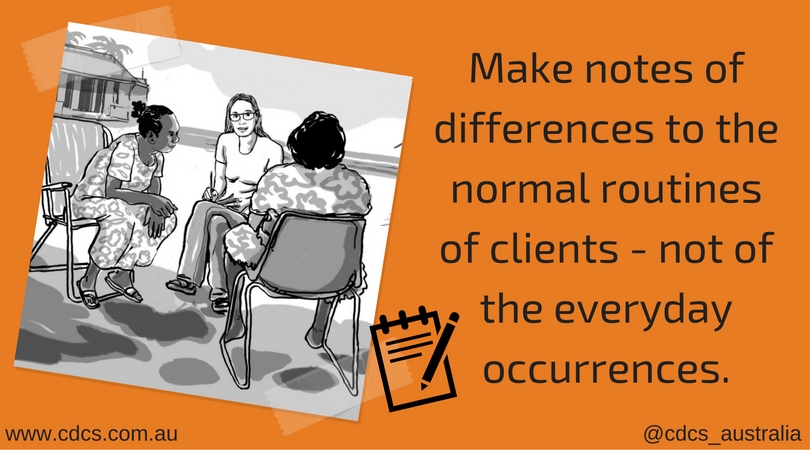Last week we looked at ways of making client documentation easier. This week we look at when to document.
Prefer to listen? Listen to the hosts of the Care Directions podcast discuss exception reporting and what and when you should be reporting.
Generally it is recommended that care staff document by exception only. This means there is no need to note down anything that follows the individual’s care plan or that is normal behaviour, just deviations from this.

For example, if Moira normally goes to the art centre on Thursday’s and her lunch is dropped off at her neighbour’s house for her to pick up later that afternoon once she returns home, there is no need for the delivery staff to note they delivered the meal to Moira’s neighbours. If, however, they found that Moira was home at the time of the delivery because she was feeling unwell that day, this should be noted.
Any event or observance that impacts on the individual’s care plan should be documented.
This would include observations of changes in:
- behaviour
- emotional state
- physical wellbeing, or
- physical appearance.
Other information that needs to be documented are incidents that have impacted on a client or relevant information that has been passed on by the client or their family carers to care staff.
The following questions may assist in identifying when documentation is required.
Did the client decline a service or was absent at the time of the planned service for any reason?
Example: Jimmy’s care plan states he has his blankets washed every fortnight, however it is now winter and Jimmy does not want to give up his blanket for washing in case it is not dry in time for the evening as he doesn’t have a spare blanket.
Was any service unable to be provided according to the person’s care plan?
Example: Sandra has a shower at the aged care centre on Monday’s and Thursday’s. This Thursday the only staff who were available were male and due to cultural reasons they were unable to shower Sandra.
Has there been a short-term change in the individual’s health?
Example: Care staff noted that Bessie has an ulcer on her leg and have informed the clinic staff. The clinic have requested that Bessie be assisted to have a shower daily and then be brought to the clinic to allow the ulcer to be dressed by the nurses.
Has there been a change in the individual’s health that will impact on the long-term care plan?
Example: Molly’s family have noted that she is wandering around at night and has started repeating herself – a dementia assessment confirms that she has Alzheimer’s.
Is there a change in the client’s appearance that is concerning?
Example: Bertie is an old stockman and is proud of his background and appearance. Staff note however that lately he has been increasingly unkempt and his clothes appear unwashed.
Has there been a change in the caring arrangement that will affect the long-term care plan?
Example: Tommy’s son, Samuel, has been caring for him, however Samuel has recently had a stroke and is no longer able to physically care for his father.
Is there a change in the family or home dynamics that may adversely impact the client?
Example: Dilys is an elderly lady who has assumed the responsibility of caring for two of her orphaned grandchildren, one of whom has a significant physical disability.
Has the client or their family made a complaint?
Example: Billy complained to the staff that the meals are too small, bland-tasting and there is not enough meat.
Whilst the general rule is ‘exception reporting’ there may be a requirement in your organisation to note something in the client’s progress notes on a weekly or monthly basis as a minimum. While there is little benefit to be gained by noting down daily or even weekly in Billy’s progress notes that there is “no change noted,” staff can be encouraged to spend time with the individual on a regular basis and note comments and observations during this conversation. Perhaps the person will reveal additional activities they have been involved in, new historical information that may be of use in care planning, changes in family dynamics or fluctuations in health status that the staff might not have already picked up on.
So to recap, ‘exception reporting’ is the standard, but if you are required to report outside of this, make sure the note is worthy of documentation.
This post is Part 2 of our four-part series on client documentation – check out our other posts now:
Part 1: 4 Ways to Make Client Documentation Easier
Part 3: 11 Tips for Writing Professional Progress Notes
Part 4: Correct Storage of Client Documentation – For Your Eyes Only!
- What’s the deal with Care Coordination? - May 21, 2024
- When Cancer Gets Up Close and Personal… - May 14, 2024
- Aged Care Packages – what’s in the box? - February 16, 2024



